2015 Top Ten
My favorite film experiences of 2015 include a few more mainstream choices than have populated my lists in year’s past. Does that mean it has been a good year for studios or a slow year for internationals, independents, and documentaries? Or are my tastes just changing?
The question of eligibility continues to be a thorny issue. Traditionally, since this is a list of my favorites, I usually just worry about what I’ve seen. Increasingly, though, the gap between when a film premieres at SXSW or Toronto or is made available for critics and when it gets broader distribution is a problem. What’s the point of a sharing a list of my ten favorites if they are films I am telling you to look for six months from now? My imperfect solution is that if I think a film has a realistic chance of getting awards consideration if/when it is distributed, I will try to wait. (Hence I delayed making a decision about Sunset Song.) If a film is not likely to get an awards push when it does come out, I’ll go ahead and recognize it now. (Hence the inclusion of the Koreeda film on this year’s list even though it is still on the festival circuit.) Last time this year I was wrestling with similar questions about The Clouds of Sils Maria and Phoenix, and while those films receded a bit with time, at least one film on this year’s list continued to grow in my estimation since the first time I saw it in 2014.
Is there a common thread in these films? Most transcended the genres they participated in or exceeded the expectations I had for them. Many were ones that others liked but maybe did not love as much as I did. Some were timeless, others timely. All had good writing and great performances.
Drum roll please…
10) Stations of the Cross — Dietrich Brüggemann
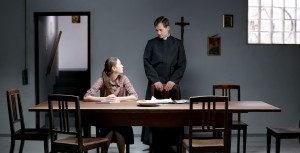 Movies about the emotionally choking effects of severe religious communities (or families) are practically a genre of their own. Stations of the Cross is divided into fourteen chapters, each told through a single take. The first, a catechism class which segues into a theological discussion showcases the sincerity of young Maria’s faith. The writing here is so strong that we are almost convinced, despite the film’s title and our own knowledge of where the stations of the cross end, that perhaps the film could have a happy ending. After all, how could people so thoughtful and sincere about their beliefs go wrong?
Movies about the emotionally choking effects of severe religious communities (or families) are practically a genre of their own. Stations of the Cross is divided into fourteen chapters, each told through a single take. The first, a catechism class which segues into a theological discussion showcases the sincerity of young Maria’s faith. The writing here is so strong that we are almost convinced, despite the film’s title and our own knowledge of where the stations of the cross end, that perhaps the film could have a happy ending. After all, how could people so thoughtful and sincere about their beliefs go wrong?
The promise and potential of young, sincere faith gradually gives way to the reality of faith in the world. Maria refuses to participate in gym class because of the demonic music the teacher plays. When the teacher turns off the music to accommodate her, other students turn against her.
Stations of the Cross is two parts horror movie, one part tragedy. We may have enough distance and maturity to see the strengths and weaknesses of the adults, to weigh the intractable demands they place on the child against the otherworldly rewards that we hope even misguided faith might earn her. The final scene is a careful, ambiguous balance of loaded images and thoughtful camera movement that can be read as one of hope for Maria or horrors for those just like her who we suspect will follow a similar path.
9) Paddington — Paul King
 I did not want to like Paddington. Disgusted by its trailer, I made a resolution to not watch it. That resolution held until it received a nomination from a critics’ group I participate in. Begrudgingly, I put in the DVD as an act of obedience and was gradually charmed by the sweetness of the bear.
I did not want to like Paddington. Disgusted by its trailer, I made a resolution to not watch it. That resolution held until it received a nomination from a critics’ group I participate in. Begrudgingly, I put in the DVD as an act of obedience and was gradually charmed by the sweetness of the bear.
It is customary these days to blame Hollywood homogeneity on the rise of franchise films, and there is truth to that accusation. But other genres are also in a bad way. Comedies are stuck in a rut of crassness and family films are afraid to have any sort of plot at all. Even relatively simple stories like Despicable Me have to give way to the utter plotlessness of Minions. Yes, Paddington has ample amounts of slapstick humor, but these scenes punctuate the film; there is, in fact a story.
And yes, I’ll go there. That story turned out to be more timely and topical in late 2015 than in the early part of the year where it was dumped. I saw Paddington in the midst of an international debate about refugees, and it seemed oddly fitting to see a story about the dangers but ultimate necessity of hospitality. Hugh Bonneville and Sally Hawkins refuse to wink or act like the movie is beneath them, and they given the Brown family a patriarch and matriarch who obviously love one another despite their differences. Another refreshing thing about Paddington is that he tries to learn and does gradually acclimate to his new surroundings. So many of these type of movies are one-note, with the scenes repeating rather than the story developing. This one allows the bear and the browns to find and love each other rather than simply focusing on one or the other.
8) Creed — Ryan Coogler
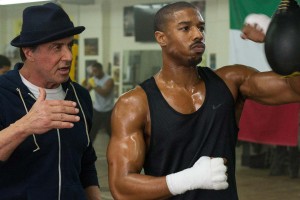 Someday, the number of people who will claim they knew Michael B. Jordan would be a superstar the moment they saw Wallace on The Wire will equal those who now claim in retrospect to have seen the genius of Leonardo DiCaprio while watching Growing Pains.
Someday, the number of people who will claim they knew Michael B. Jordan would be a superstar the moment they saw Wallace on The Wire will equal those who now claim in retrospect to have seen the genius of Leonardo DiCaprio while watching Growing Pains.
Jordan is all that, but I love films that are not afraid to surround the protagonist with characters who are interesting in their own right. If you go back and watch the original Rocky, which I did, you might be surprised at how little of it is really about the match. That film spends as much time on Rocky’s and Adrian’s date as it does on the climactic match with Apollo Creed.
This franchise reboot is also a bit more interested in how its protagonist develops his relationships in and out of the ring than in whether or not he will win the climactic bout. Donnie’s ultimate victory is that he discovers other things to care about besides his father’s legacy. Creed’s ultimate success is in making us identify with and root for Donnie. We don’t just want him to win; we also want him to be happy. Creed, like Rocky, also has the audacity to suggest that even in toxic cultural environments that exploit and exaggerate racial tensions, Blacks and Whites can be friends and may share similar dreams, fears, and aspirations.
7) The Big Short — Adam McKay
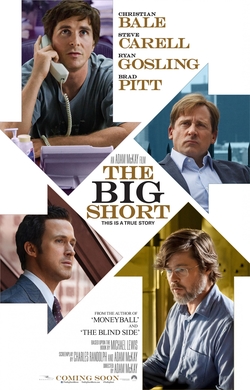 Adam McKay’s The Big Short starts with the proverbial two strikes. As far as content, it is about the 2008 market collapse catalyzed by (implied) corruption and incompetence in and around the American mortgage industry. In terms of form, it dabbles with an “aren’t I clever?” breaking of the fourth wall to explain financial concepts to presumably economically illiterate viewers.
Adam McKay’s The Big Short starts with the proverbial two strikes. As far as content, it is about the 2008 market collapse catalyzed by (implied) corruption and incompetence in and around the American mortgage industry. In terms of form, it dabbles with an “aren’t I clever?” breaking of the fourth wall to explain financial concepts to presumably economically illiterate viewers.
It is admittedly late in the game to assume that anyone who bothers to watch such a movie has not yet figured out what a credit default swap is, but fortunately these vignettes are not overdone. As I wrote in my full review, The Big Short‘s home run move is having the audacity to tell this story not from the point of view of the victims (see 99 Homes) but from that of those who anticipated and prospered from this economic calamity.
Great artists understand that changing the angle of observation can dramatically alter the features of any story. The Big Short’s focus on those who see it coming rather than those who are blind sided, raises a fascinating set of moral questions surrounding what it means to be advantaged in an unfair system and whether those who are advantaged have any responsibilities to those who do not have the education, information, or ability to understand what they do.
That shift in perspective also helps the film avoid the trap of one-note finger wagging, thus giving some of our best actors of the moment meaty roles through which to deliver nuanced performances. Carell’s slow burn disillusionment is riveting. Gosling’s salesmanship bravado lets us wonder where pitch ends and conviction begins. Christian Bale gives us a portrait of a man so confident he comes across as arrogant. In a typically low-key but absolutely brilliant moment, the man who has spent the whole film assuming he is right and everyone else is crazy has to decide whether or not it is even possible that he could be wrong.
In Rudyard Kipling’s “If,” the poet postulated that the mark of being a man is the ability to keep your head while all about you are losing theirs. That sort of grace under pressure is certainly one mark of maturity, but it is not the only one. Today’s systems are wrapped in obfuscation and jargon to intimidate the average person and make him or her more likely to defer to experts. Today, the courageous individual may be the one who refuses to be guided by consensus, no matter how widely accepted it is, when the facts say otherwise. It is not so much about speaking the truth to power as it is about speaking the truth when power shouts over you, ridicules you, and tells everyone who will listen that you are an idiot.
6) (Dis)honesty: The Truth About Lies — Yael Maelmede
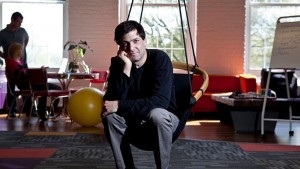 Pop quiz: what are the factors, social, political, or environmental that make you more prone to lying? Pencils down. If you answered, “none, honesty is a personal virtue that people have to greater or lesser degree irrespective of the context in which they operate” you just failed.
Pop quiz: what are the factors, social, political, or environmental that make you more prone to lying? Pencils down. If you answered, “none, honesty is a personal virtue that people have to greater or lesser degree irrespective of the context in which they operate” you just failed.
That’s a controversial claim, but Dan Ariely’s research, summarized and illustrated in the film, appears to bear it out. We are all dishonest to one degree or another. This shouldn’t be shocking news, especially to Christians who believe in original sin and the moral imperfections of even the redeemed. Why then is it so hard to accept?
Ariely’s research, described in this review from Evan Cogswell, asks a more specific question than “how much do people lie?” It is, “How much can people lie and still consider themselves to be honest?” The case studies in the film end up illustrating not why people lie (we often don’t know ourselves) but how they rationalize and justify doing so to themselves or others. The film also touches on, however briefly, the policy implications of Ariely’s research? (Do small cheaters or big cheaters have a bigger impact on the community and how should we attempt to regulate such behaviors?)
Although 2015 has been a fun and fruitful year at the movies overall, I haven’t seen as many documentaries that really excited me. The pendulum also appears to be swinging in the evaluation of this genre, with critics as interested in filmcraft and innovations regarding how the story is told as they are in the relevance or interest of the material presented. (Dis)honesty is, admittedly, a talking heads documentary. As such, it is not flashy. But its ideas are interesting, relevant, and skillfully explored.
5) Spotlight — Tom McCarthy
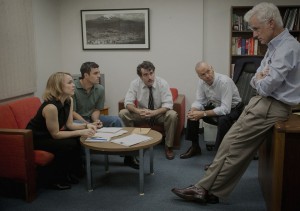 The leader in the clubhouse for this year’s Oscar, Spotlight checks many of the boxes that describe the sort of film critics and academies like to honor.
The leader in the clubhouse for this year’s Oscar, Spotlight checks many of the boxes that describe the sort of film critics and academies like to honor.
It features a strong, ensemble cast of popular actors, several of whom are “due” for recognition. (Michael Keaton is riding a resurgence from last year’s Birdman and Stanley Tucci has the same reservoir of career good-will that propelled J. K. Simmons to his first award for last year’s Whiplash.)
Also due is writer/director Tom McCarthy. Fans of The Station Agent, Win Win, The Visitor or Up won’t be surprised at how good the writing is here; when an up-and-coming artists finally hits it big, there is usually an additional bump from those (myself included) who feel vindicated for their praise of his previous work.
Its subject matter–journalistic investigations into allegations of widespread clergy sex abuse in the Boston area–is sufficiently serious to appease those who think the most lauded films should be culturally relevant and not just entertaining. Spotlight is not just a good film, it is an important one. I would not begrudge it a single accolade.
Can Spotlight still be derailed? Absolutely. As with most “true” stories, it has to try to balance absolute historical accuracy with making the story line accessible to audiences.
I once heard a church speaker opine that a good sermon will have points of connection for the newly informed, the expert, and those in-between. Movies that seek to inform are much the same way. Like The Big Short, Spotlight has to be able to speak to those who are well informed about its events and those hearing about them for the first time. The danger in speaking to the latter (which is usually the bigger group) is that one can come across as having or using too much hindsight. Spotlight‘s strongest point is that it capture the emotional impact of truth’s revelations. For all the testimonials of abuse, the film’s most devastatingly powerful moment may be one of stunned silence as the team of reporters begin to realize the scope of their story is even bigger than they have anticipated. Like the investors of The Big Short, the reporters have to come to terms with the ambivalence engendered by a job where their personal success comes at the expense of other people’s suffering. The truths they uncover may lead to journalistic accolades, but sometimes ignorance really is bliss.
4) Mad Max: Fury Road — George Miller
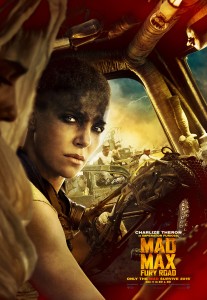 “If you can’t fix what’s broken…”
“If you can’t fix what’s broken…”
Fully satisfying as to theme, this is a throwback only in the sense that it reminds us of how much more thrilling stunts are than special effects. The choreography and editing is off-the-charts good…and a welcome relief to those of us weary of the uberfrenetic shot sequencing of The Avengers and its progeny.
This is essentially one long chase scene, but backstory and theme are interspersed, and it’s the rare action movie that shows rather than tells. That is, rather than having exposition set up the stakes for the action, we see characters revealed through the action.
Good science fiction, good action, can never be exclusively about the adrenaline rush. There are points to ponder here about our dehumanization, but it’s not entirely nihilistic. That bits and pieces of humanity remain makes us speculate as to whether that’s a good thing, whether the will to survive is all that there is or all there needs to be.
No special effects will ever match the power of the human face, the human body. Miller’s world is one in which the line between life and death is thinner than ever. The thinness of that line, however, doesn’t simply make life cheap. Rather it makes the people who are forced to straddle that line ask the same question we are confronted with: what makes life worth living?
3) Brooklyn — John Crowley
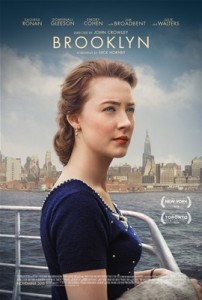 One of the surest indicators of my affection for a film is how quickly I roll my eyes when people criticize it.
One of the surest indicators of my affection for a film is how quickly I roll my eyes when people criticize it.
It’s not that I think John Crowley’s film is above criticism; no film is. It’s just that I can’t quite understand people who care more about picking nits than savoring the films simple yet increasingly rare pleasures.
Foremost among them is some really stellar world building. Brooklyn‘s leisurely pace helps us understand Eilis (Saoirse Ronan) from the inside out, and while most films in the romance genre coerce sympathy for the lovers by skimping on characterization for everyone else, Brooklyn takes the time to show us the bad and good of the people who inhabit their world. I suspected I was in for a different kind of experience when a depressed Eilis is confronted by her boss (Jessica Paré); a lazy film would have the elder woman pile on. Here the woman’s coldness is mixed with a streak of humanity. When Jim Broadbent shows up as a Catholic priest who does his best to serve and help his parishioners, I realized I was watching a film about people rather than about literary or cinematic stereotypes.
Speaking of Ronan, it feels like she’s been on the cusp of superstardom for as long as we’ve known of her, waiting only for a role that would showcase her tremendous talent rather than use it to bolster a weak story (The Lovely Bones; Hanna) or subordinate it to an ensemble piece (Byzantium, Grand Budapest).
I’ve heard some chatter that Brooklyn‘s resolution is too quick and that Eilis’s tarrying in Ireland undercuts the strength of the bond she feels with the city and man she left behind. I understand these criticism, but I don’t really agree with them. This film is called Brooklyn, not Eilis’s Love Triangle, and the film is pretty transparent about positioning itself as a allegory and its heroine as a representative of a fundamental American experience.
2) Our Little Sister — Hirokazu Koreeda
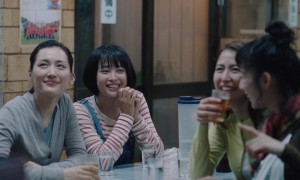 Goodness is hard. It is hard to be a good person in real life, and it is surprisingly hard to depict good, decent people on film.
Goodness is hard. It is hard to be a good person in real life, and it is surprisingly hard to depict good, decent people on film.
Our Little Sister can’t help but draw comparisons to Yazujiro Ozu’s Tokyo Story, but I find it more optimistic. While the Ozu movie always strikes me as fatalistically saying that family is destiny, Koreeda’s film seems to me about siblings who are still striving to overcome or transcend the family dynamics that may soon settle as a hard shell over and around their hearts.
The film opens as three sisters attend the funeral of the father that abandoned them long enough ago for their nicest feelings about him to be indifference. But arriving at his village, meeting their step-sister, and becoming aware of the life he continued to lead after he was no longer a presence in their own, reopens the deep wounds they feel over their abandonment. It is human nature in such instances to take out one’s resentment on the person who is present whether or not she is the cause of your distress.
At the core of Our Little Sister’s poignancy is a conflicted bond between the eldest and the youngest. Both see in the other someone who can help heal a familial wound, but each approaches the relationship with a totally understandable mix of fear (from vulnerability) and anger (over perceived preferential treatment). As in many families, each sibling feels as though she has gotten the short end of the stick. Dad abandoned me and stayed with you…you got the best years of his life…he was richer and had more to give…he was younger and needed less care-taking. These arguments aren’t always verbalized, but they form the unmistakable subtext that touches nearly every daily task and imbues each of them in tension.
Koreeda’s films can cut to the bone, but they also have the capacity to be amazingly tender. When progress is slow, little steps are easier to cherish. Just when you think one party must always make the sacrifices, another rises to the occasion. Ultimately, what the film understands is that sacrifice coming from a place of love will always come more quickly and easily than that made out of a sense of duty.
1) Love & Mercy — Bill Pohlad
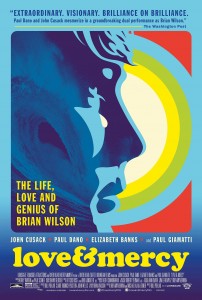 I’ve already written in detail about Bill Pohlad’s biographical sketch of Brian Wilson, both here and at Christianity Today Movies & TV.
I’ve already written in detail about Bill Pohlad’s biographical sketch of Brian Wilson, both here and at Christianity Today Movies & TV.
Rather than repeat or summarize those reviews, I’ll say a few words about two scenes that have choked me up each of the four times I’ve screened the film.
The first is the first date between the adult Brian (John Cusack) and the care saleswoman, Melinda (Elizabeth Banks), who is more intrigued by his vulnerability than disgusted at his entourage. Brian, as broken as he is, has a disarming honestly that engenders both trust and courage. When Melinda says the man she was formerly with broke her heart, Brian says simply and sincerely, “He shouldn’t have done that.”
The second is a scene when Brian’s doctor, Eugene Landy (Paul Giamatti) storms into Melinda’s workplace, screaming at her through a locked office door. Melinda is safe behind the door, but she sensea, as do we, that she must face Dr. Landy, so she opens the door, stepping into the breach to meet in adversary. In doing so, she not only stands up to a bully, she discovers how often love provides the courage that fear tries to drain from us. What happens next is electric, a moment between two actors at the peak of their craft, both fully capable of communicating without speaking.
The film is ostensibly about Brian, but it is told from the perspective and through the eyes of Melinda. She is our surrogate. Pay attention to how often director Bill Pohlad leaves the camera on Melinda as Brian as talking. Banks, in a stunning performance, is responsible for walking us through the emotional turmoil of Brian’s experiences so that Cusack can tell her (and us) about excruciating pain with the nearly numb, cavalier offhanded tone that is more effective than the weeping of gnashing of teeth.
Cusack, too, is in fine form, dialing it back just enough where lesser actors would push on into histrionics. At the film’s press conference at SXSW, Cusack appeared with Wilson and confirmed that he spent as much time with the singer as possible to try to understand the man he was portraying. Wisely, though, he eschews mimicry in favor of striving to replicate the pace and cadence of a wounded warrior.
Roger Ebert once suggested that the greatest structural challenge in romances is not how to bring the lovers together but how to credibly keep them apart once the audience wants them together. Love & Mercy convinces us that these two people belong together, but because of Brian’s frailty and vulnerability, we are never confident he will be able to act the way he wants and the way we want him to.
“It is such a happiness,” Jane Austen had a character declare, “when good people get together.”
Fewer films in the last few years have made me happier than Love & Mercy.
—
Ten honorable mentions: The Martian, 99 Homes, Honor Thy Father, Everest, Mission Impossible: Rogue Nation, BaddDDD Sonia Sanchez, Blackhat, Inside Out, Welcome to Leith.

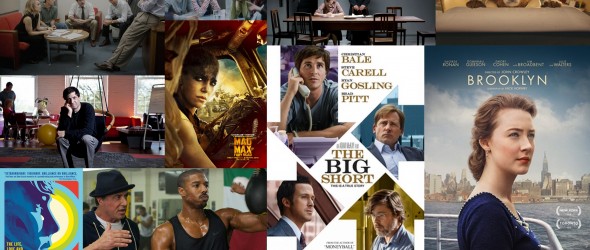
What a refreshing list. I finally feel like I agree with someone on enough of these films that I need to seek out the others I haven’t seen. Nice to see Paddington singled out for first time on any list I’ve seen. My own choke-up moment in Love and Mercy happens when the younger Brian Wilson is running around the studio like a 4-year-old with a fire helmet on while Surf’s Up plays in the background.
That’s a great moment in a great film.